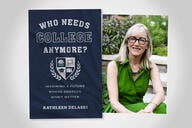You have /5 articles left.
Sign up for a free account or log in.
Professors and academic leaders from seven western states have rolled out an “interstate passport” to help students transfer across state lines without losing credits for what they learn in general education courses.
The Western Interstate Commission for Higher Education helped lead the project, which has been in the works for five years. The Carnegie Corporation, the Lumina Foundation and the Bill & Melinda Gates Foundation have contributed funding.
“The passport is designed to improve graduation rates, shorten time to degree and save students money,” the commission said.
A framework of required learning in nine knowledge and skill areas (listed in box, below) is the passport’s undergirding. Faculty members at participating institutions can create a “passport block,” or a list of courses and other learning experiences that satisfy the learning requirements in the nine areas.
Students who complete those courses with a grade of C or better can transfer to another participating college without having to repeat course work for the lower division, general assignment courses that correspond to that institution’s passport block.
Now that the passport is complete, any nonprofit, regionally accredited institution can apply to participate, said Patricia Shea, WICHE’s principal investigator for the project.
A group of 16 institutions in the West took part in a pilot version of the passport, including both community colleges and four-year institutions. A dozen of the colleges awarded passports to 7,000 students over two years.
“The currency of transfer is a set of learning outcomes,” Shea said. “It’s not based on course-by-course articulation, but the learning the student achieved.”
The framework’s faculty member creators developed examples of “proficiency criteria” for how students can demonstrate what they know and can do in each of the nine required areas of learning. This wide range of course assignments and exercises varies across disciplines, can span multiple learning outcomes and includes a range of formats, such as written, oral, visual and group assignments.
For example, quantitative literacy is one of the passport’s nine learning areas. It includes the required learning outcome of being able to “demonstrate proficiency with arithmetic and algebraic computational skills, and extend them, for example, to geometric and statistical computations.” Possible ways of demonstrating that proficiency include the "use of logarithms to correctly solve a compound interest problem, or to solve linear and quadratic algebraic equations accurately and reliably without the aid of a calculator.”
Passport's Nine Knowledge & Skill Areas
Oral communication
Written communication
Quantitative literacy
Natural sciences
Human cultures
Creative expression
Human society and the individual
Critical thinking
Teamwork and value systems
The passport gives a wide range of latitude to each participating college. It does not, for example, require the use of specific assessments or other ways for students to demonstrate proficiency. And the framework doesn’t spell out which courses a college should count toward learning outcomes.
However, the project also includes mechanisms for seeking to assure academic quality.
Through a partnership with the National Student Clearinghouse, a nonprofit that can track 98 percent of the nation’s college students, registrars and institutional researchers at participating colleges will be able to follow the academic progress of their former, passport-holding students. That way they can see whether the passport adequately prepared transfer students to succeed. Participating colleges also can use the Clearinghouse data to see if an incoming student has earned a passport.
“The passport is built on the principle of trust but verify,” Shea said in an email. “Faculty at each institution determine how its students achieve the passport learning outcomes, and the tracking system provides the sending institution with data on the academic progress of its former students for continuous improvement efforts as appropriate.”
Praise and Criticism
Several experts on college transfer and efforts to measure learning praised the project.
Cliff Adelman, a senior associate at the Institute for Higher Education Policy, is a co-author of the Degree Qualifications Profile, an effort to map out what students should know and be able to do upon completion of a degree. Adelman said he was delighted that the passport “invokes cognitive-based learning outcome categories” for its framework.
“It’s going to be tough for some schools to document everything,” he said via email. “But bless them for the effort.”
Likewise, Davis Jenkins, a senior research associate at the Community College Research Center at Columbia University’s Teachers College, said the passport is “very forward thinking not just in its interstate focus but in defining learning outcomes in terms of competencies.”
Jenkins has studied and written about the many barriers community college students face in transferring. A key challenge for the passport, he said, would be to get four-year institutions to sign on and accept the general education competencies for credit.
In addition, four-year colleges increasingly have pushed program requirements for majors into the lower divisions, Jenkins said, which has long been the case in STEM disciplines. “So the question is how the passport competencies relate to competencies required for particular majors.”
Carol Geary Schneider, a prominent voice on both learning outcomes and general education, is a critic of the project.
“It’s a good idea gone awry,” said Schneider, who this month stepped down after a long stint as president of the Association of American Colleges and Universities, which the passport project relied on in developing its learning outcomes. “The devil is in the design.”
The passport’s reliance on grades and course completions, which Schneider calls “first-draft indicators of achievement,” fails to adequately show whether a student has achieved learning outcomes. She said the passport instead should have used nationally available metrics, such as her group’s Valid Assessment of Learning in Undergraduate Education rubrics.
The project is “trying to split the difference between speedy, unimpeded transfer and demonstrated student achievement of learning outcomes,” she said. “But the current plan is long on the first goal and weak on the second.”
In addition, Schneider said, faculty members at participating colleges may lack the resources to adequately “validate” outcomes under the passport. And the result will be a “race to reduce the challenges put before our students.”
Shea countered that faculty members said during the passport’s creation that they needed more “granular” outcomes than those spelled out in AAC&U’s metrics.
In addition, she said, the project’s next phase will feature a partnership with the National Center for Higher Education Management Systems, often called NCHEMS, to use broadly accepted rubrics with the passport.
The U.S. Department of Education’s is chipping in $3 million for the project, some of which will pay for the work with NCHEMS to “engage lower-division general education faculty at partner institutions in a closer look at how and what types of evidence are being used to determine the same lower-division general education competencies,” WICHE said in a written statement.
For now, though, the passport defers to local faculty members on how to determine students’ competencies. And Shea said the completion of courses remains central to measuring student progress.
“We’re really about creating a passport in a way that respects the autonomy of the institution and the faculty,” she said.




